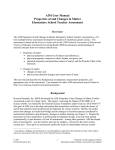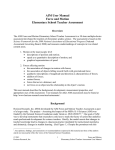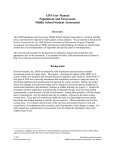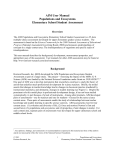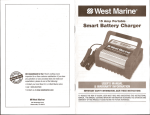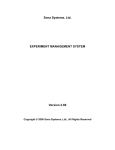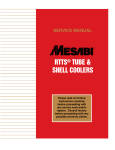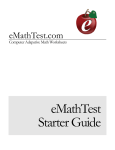Download AIM Properties of and Changes in Matter
Transcript
AIM User Manual Properties of and Changes in Matter Middle School Teacher Assessment Overview The AIM Properties of and Changes in Matter Middle School Teacher Assessment is a 30-item multiple-choice assessment developed for middle grades science teachers. The assessment is based on the Science Framework for the 2009 National Assessment of Educational Progress (National Assessment Governing Board, 2008) and measures understandings of concepts in two related content areas. 1. Properties of matter physical properties common to all objects and substances; physical properties common to solids, liquids, and gases; and chemical properties and particulate nature of matter; and the Periodic Table of the Elements. 2. Changes in matter changes of state; and physical and chemical changes and conservation of mass This user manual describes the background, development, measurement properties, and appropriate uses of the assessment. User manuals for other AIM assessments may be found at http://www.horizon-research.com/aim/instruments/. Background Horizon Research, Inc. (HRI) developed the AIM Properties of and Changes in Matter Teacher Assessment as part of a larger study. The project—Assessing the Impact of the MSPs: K–8 Science (AIM) was funded by the National Science Foundation under Grant no. DUE-0928177.1 One goal of AIM was to develop instruments that researchers could use to study the theory of action that underlies much professional development for science teachers. Briefly, the model asserts that changes in teacher knowledge lead to changes in classroom practice (mediated by instructional materials), and ultimately, changes in student learning (see Figure 1). Despite the prominent role this model plays in professional development design, it has not been studied systematically, in part because of a lack of instruments. Among other products, AIM developed pairs of assessments—one for teachers and one for students—focused on the same science content area. These pairs of assessments enable the study of relationships between teacher 1 Any opinions, findings, and conclusions or recommendations expressed in this material are those of the authors and do not necessarily reflect the views of the National Science Foundation. © 2013 Horizon Research, Inc. 1 Properties of and Changes in Matter Middle School Teacher Assessment User Manual knowledge and student learning in specific science contexts. AIM assessments exist for four content areas: (1) evolution and diversity of life; (2) force and motion (Newton’s first and second laws); (3) populations and ecosystems; and (4) properties of and changes in matter. For each content area, separate pairs of assessments were developed for elementary school and middle school levels. Professional Development Theory of Action Professional Development Improved Teacher Content Knowledge for Science Teaching Improved Classroom Practice Increased Student Achievement Instructional Materials Figure 1 To enable large-scale research, HRI set out to create assessments that would be minimally burdensome, both for the test-taker and the researcher. Accordingly, HRI opted for a multiplechoice format, recognizing the limitations of such items. For instance, well-constructed, openended items may probe more depth of understanding than multiple-choice items, but they are more burdensome for both the researcher (in terms of scoring costs) and the test-taker (in terms of time required to complete the assessment). In addition, scoring open-ended items requires the training of raters to establish inter-rater reliability. Development of the Properties of and Changes in Matter Middle School Teacher Assessment As described above, this development effort was part of a much larger and well-funded project, which afforded a thorough development process, (see Figure 2). © 2013 Horizon Research, Inc. 2 Properties of and Changes in Matter Middle School Teacher Assessment User Manual Assessment Development Process Three Ph.D.s in content area unpack and clarify the science content to be assessed Write multiple choice items Collaborative item editing Conduct cognitive interviews with teachers/students Revise items Review by a Ph.D. in content area Pilot multiple choice items with teachers/students Conduct IRT analyses and construct scale Figure 2 Clarifying the Content Domain Development began with identifying the target content for the properties of and changes in matter assessments. We used the 2009 NAEP Framework for direction on the content of the AIM assessments. The NAEP Framework was based primarily on the National Science Education Standards (National Research Council, 1996) and the Benchmarks for Science Literacy (American Association for the Advancement of Science, 1993), but also reflected developments in science and policy that have taken place since those documents were published. HRI specified the assessment domain using two strands in the NAEP Framework: (1) properties of matter, and (2) changes in matter. This process had three chemists/chemistry educators “unpack” the content into series of “sub-ideas” for middle school students. Additional sub-ideas that are important for teachers to understand in order to teach the middle school student ideas were also specified by the content experts. Both sets of ideas were considered in developing the middle school teacher assessment. The final description of the content domain is shown in Table 1. © 2013 Horizon Research, Inc. 3 Properties of and Changes in Matter Middle School Teacher Assessment User Manual Table 1a Properties of and Changes in Matter Content Domain Properties of matter. Physical properties common to all objects and substances and physical properties common to solids, liquids, and gases; chemical properties, particulate nature of matter, and the Periodic Table of the Elements Sub-ideas for students: Materials have properties. o The properties of anything are the characteristics used to describe that thing, such as color, weight (mass), size, and so on. o Various objects and substances (materials) can be identified and distinguished by their properties. Weight (mass) and volume are properties that can be measured using appropriate tools. o Properties of a sample may be measured (quantitative properties) or described using the five senses (qualitative properties). o Weight is the property of matter that makes it resist efforts to move or lift it and is usually measured with scales or balance. Qualitatively, the weight of a quantity of matter is often characterized as “heavy” or “light.” o Volume is the property of matter that tells us how much space the matter occupies. Qualitatively, the volume of a quantity of matter is often characterized as “large” or “small.” Objects (materials) vary in the extent to which they absorb and reflect light and conduct heat (thermal energy) and electricity. o Different objects absorb different colors of light that strikes them and reflect other colors, which give the objects the colors we observe. o Some objects allow electricity to easily pass through them (conductors) and others do not (insulators). o Some objects allow heat (thermal energy) to easily pass through them and others do not. Permanent magnets can repel or attract other permanent magnets. o Permanent magnets are bipolar. One pole is usually called the “north pole” and the other the “south pole.” The unlike poles of permanent magnets attract one another and the like poles repel. Permanent magnets can also attract certain materials (induced magnets) at a distance. o Some materials (induced magnets) are attracted to magnets. o Some materials (non-magnets) are not attracted to magnets. Materials exist in several different states; the most common states are solid, liquid, and gas. Each state of matter has characteristic properties. Samples of materials can be classified by their behavior into solids, liquids, and gases. o Solids have a definite shape and volume that cannot be easily changed. o Liquids flow to take the shape of their container and have a definite volume that cannot be easily changed. o Gases expand to fill any shape and volume container and can easily be compressed into a smaller volume container. Some objects are composed of a single material; others are composed of more than one material. o Some materials can be separated (decomposed) into two or more different materials. o Some materials cannot be separated (decomposed) into different materials. Properties of solids, liquids, and gases are explained by a model of matter that is composed of tiny particles in motion. o The tiny particles that are always moving are far smaller than is easily imaginable – a tablespoon of water contains about 500 billion trillion of these water particles. o Particles in motion possess kinetic energy. Elements are a class of substances composed of a single kind of atom. o Elements are substances that cannot be changed (i.e., decomposed) by heat or an electric current (chemical means) into other substances. o Elements represent the “building blocks” of all samples of matter. o An atom is the tiny particle of matter that is the smallest unit that makes up the unique properties of a particular elemental substance. All the particles (atoms) of an elemental substance are the same. In particular, the atoms of an element all have the same mass (neglecting isotopes at this level). o The atoms of different elemental substances are different from one another. In particular, the atoms of different elements have different masses. Compounds are composed of two or more different elements. o Compounds are substances that can be changed (broken down) by heat or an electric current (chemical means) into two or more different elemental substances. o Each compound is made up of a fixed proportion of elements and possesses a definite formula. o A molecule is the tiny particle of matter that is the smallest unit that makes up the unique properties of a particular compound substance. These properties, including size, arrangement, and mass, are independent of the quantity and temperature of the compound substance. o Molecules of a compound are made up of atoms of two or more different elements firmly attached (bonded) to one another so that it takes a great deal of energy (heating or electrical) to break them apart to the separate elements. o The arrangement of the atoms in a molecule is an orderly three-dimensional structure that is determined by the properties of the atoms. The arrangement of atoms is identical for all molecules of a particular compound. Different arrangements of atoms in molecules results in different properties. Each element and compound has physical and chemical properties, such as boiling point, density, color, and conductivity, which are independent of the amount of the sample. (Although this content statement is generally true, some compounds decompose before boiling.) o Physical properties can be observed or measured without changing the identity/composition of a substance. o Chemical properties [such as flammability (burning) or the amount that dissolves in water] involve changes in the composition of the matter. The changes produce different substances by rearranging the attachments (bonds) among the atoms of which the original substances are composed. Chemical properties are only observed by changing a substance into one or more different substances. o Density is the amount of matter (mass) that occupies a given amount of space (volume). (continued) © 2013 Horizon Research, Inc. 4 Properties of and Changes in Matter Middle School Teacher Assessment User Manual Table 1a (continued) Properties of and Changes in Matter Content Domain Properties of matter. Physical properties common to all objects and substances and physical properties common to solids, liquids, and gases; chemical properties, particulate nature of matter, and the Periodic Table of the Elements Sub-ideas for students: Samples of matter are classified according to their physical and chemical properties. Metals and acids are examples of such classes. (Acids, depending on the definition, often are not substances, but rather aqueous solutions. And some metals are alloys or solid solutions, not substances either.) The class of elements called metals exhibit characteristic physical properties such as conductivity and characteristic chemical properties such as reacting with nonmetals to produce salts. o Elements can be classified, based on their respective physical and chemical properties, as metals, nonmetals, and metalloids (semi-metals). o A majority of known elements are metallic. o Metals are generally good electrical and thermal conductors. o “Salt” is a general chemical term for compounds of a metallic element with a nonmetallic element found near the right-hand side of a conventional periodic table. Common table salt is only one example. Acids are a class of materials that exhibit common chemical properties, including a sour taste, characteristic color changes with litmus and other acid/base indicators, and the tendency to react with bases to produce a salt and water. o Water solutions can be classified as acidic, basic, or neutral, given their characteristic behavior with acid-base indicators such as litmus, or via their chemical behavior. o Acids can be either strong or weak; acetic acid (vinegar) and citric acid are examples of weak acids; sulfuric acid and hydrochloric acid are typical strong acids. o Acid/base indicators are dyes, like litmus, that are one color in acidic solution and another contrasting color in a basic solution. o Bases are a class of compound that exhibit common chemical properties, including bitter taste, characteristic color changes with litmus or other acid/base indicators, and the tendency to react with acids to produce salt and water. Chemical properties of substances are explained by the arrangement of atoms and molecules. o A chemical property of a substance involves a change in the original substance to a new substance. o Molecules are composed of particular numbers and types of atoms. o The three-dimensional arrangement of atoms attached together in a molecule determines how the molecule interacts with other molecules and the kinds of (chemical) changes that can occur. All substances are composed of 1 or more of approximately 100 elements. o There are only about 100 naturally occurring elements in the universe. o All matter is composed of approximately 100 different elements. o Elements and compounds are all considered substances. o Each substance is composed of one or more particular types of elements; each substance has constant composition. The periodic table organizes the elements into families of elements with similar properties. o Elements can be classified and identified by their properties. o An element’s chemical properties – its reactivity and, particularly, its combining characteristics with oxygen (oxides), hydrogen (hydrides), and chlorine (chlorides), allow it to be grouped with other similarly-behaving elements. o When the elements are listed in order of increasing atomic mass, elements with very similar properties (densities, chemical reactivities, and so on) occur at intervals in the list. Converting the list to a table with elements in increasing atomic mass across the rows and elements sharing similar properties arranged in columns created the periodic table of the elements. (The listing is in order of atomic number, not atomic mass, but with only a couple of exceptions the orders are the same and atomic number is not necessary at this level.) © 2013 Horizon Research, Inc. 5 Properties of and Changes in Matter Middle School Teacher Assessment User Manual Table 1b Properties of Matter Content Domain Properties of matter. Physical properties common to all objects and substances and physical properties common to solids, liquids, and gases; chemical properties, particulate nature of matter, and the Periodic Table of the Elements Sub-ideas for teachers: “Substances” refer to either elements or compounds and should not be used as a synonym for “materials” or “objects.” A substance is matter that can be found in many places and has the same properties wherever it is found. Water, for example is a substance that always melts from ice to liquid water at 0°C, no matter what its source. An object is a particular, individual piece of matter that has unique properties. A particular iceberg, for example, is made mostly of ice, but has a unique size, shape, weight, and so on. Distinguish for yourself that the “strength” of an acid is not the same as its “concentration” – these are very different concepts; the choice of teacher language should accurately reflect this distinction. Understanding of closed vs. open systems and implications for conservation of mass. Mass in only conserved in a closed system; in an open system (e.g., an open pot of water on a stove), where mass can move in and out, mass is not conserved. © 2013 Horizon Research, Inc. 6 Properties of and Changes in Matter Middle School Teacher Assessment User Manual Table 1c Changes in Matter Content Domain Changes in Matter: Changes of state ; physical and chemical changes and conservation of mass Sub-ideas for students: One way to change matter from one state to another and back again is by heating and cooling. o Melting and freezing are terms for opposite changes in state, (melting is solid liquid; freezing is liquid solid). o The melting point is the temperature at which a solid melts to form the liquid state of the substance. The freezing point of a liquid is the temperature at which the liquid freezes to form the sold state of the substance. For any particular substance (material), melting and freezing points are the same. o Heating a solid can raise its temperature to the melting point and continued heating will melt the solid. o Cooling a liquid lowers its temperature to the freezing point and continued cooling will freeze it into a solid. o Boiling (vaporizing) and condensing are opposite state-change processes. (Although similar statements can be made about the liquidto-gas and gas-to-liquid changes of state, the concepts of vapor pressure and atmospheric pressure are involved and these are not suitable at this level, so it is just as well to say that boiling and condensing are similar to melting and freezing and not try to define boiling quantitatively. Changes of state are explained by a model of matter composed of tiny particles that are in motion. o Particle motion in a solid is limited to vibration in fixed positions, while particles in liquids and gases can move randomly. o Adding energy to a substance by putting it in contact with a hotter object raises the temperature of the substance, causing its molecules to move faster. The consequences for a solid substance can be melting (as the atoms or molecules move faster and overcome the mutual attractions holding them in place). The consequences for a liquid substance can be vaporization (atoms or molecules leaving the liquid to become a gas as they move faster and overcome the mutual attractions holding them in the liquid). o Removing energy from a substance by putting it in contact with a colder object lowers the temperature of the substance, causing its molecules to move slower. The consequences for liquid and gaseous substances are just the reverse of those described in the previous paragraph. o Temperature relates to the speed of particle motion – that is, to a sample’s kinetic energy. When substances undergo changes of state, neither atoms nor molecules themselves are changed in structure. o “Structure” here is the three-dimensional arrangement of atoms bonded to form molecules. (When referring to atoms, structure refers to the arrangement of electrons and nuclei, but this is beyond the concepts included in these statements and is meaningless in this statement). o Changes of state represent physical changes, not chemical changes. o The identity of a substance remains unchanged while undergoing a change in state. Mass is conserved when substances undergo changes of state in a closed system. o “Conservation” in this context means that the subject of interest (mass, here) is the same before and after a change. Chemical changes occur when one or more substances (elements or compounds) react to produce one or more different substances with differing physical and chemical properties from the reacting substances. o A reaction is the change that occurs when atomic attachments (bonds) are rearranged. o Reactants are the substances that come together and change in a chemical reaction. o Products are the substances that are produced by the changes in a chemical reaction. o Evidence for occurrence of a chemical reaction is provided by noticeable and permanent change in the properties and appearance of the reactants. When substances undergo chemical change, the total number and kinds of atoms in the reactants are the same as the number and kinds of atoms in the products. o Chemical change produces different substances by rearranging the attachments (bonds) among the atoms of which the original substances are composed. o Chemical change involves the rearrangement of atoms involved, not the transformation, creation, or destruction of any of those atoms. o The number of reacting molecules may change in a chemical reaction, but not the total number of atoms; total atoms are conserved, total molecules may not be. Mass is conserved when substances undergo chemical change. The mass of reactants is the same as the mass of products. © 2013 Horizon Research, Inc. 7 Properties of and Changes in Matter Middle School Teacher Assessment User Manual Table 1d Changes in Matter Content Domain Changes in Matter: Changes of state ; physical and chemical changes and conservation of mass Sub-ideas for teachers: The same particles are present before and after a state change. Understand common applications of changes in state, particularly the energetics involved (adding/ removing heat), such as in condensation on drinking glass and wet skin feeling cool. Sublimation and deposition are terms for opposite changes in state; sublimation is solid gas, deposition is gassolid. Adding energy to a substance by putting it in contact with a hotter object raises the temperature of the substance, causing its molecules to move faster. The consequences for a solid substance can be melting (as the atoms or molecules move faster and overcome the mutual attractions holding them in place). The consequences for a liquid substance can be vaporization (atoms or molecules leaving the liquid to become a gas as they move faster and overcome the mutual attractions holding them in the liquid). Removing energy from a substance by putting it in contact with a colder object lowers the temperature of the substance, causing its molecules to move slower. The consequences for liquid and gaseous substances are just the reverse of those described in the previous paragraph. During a phase change, continued heating or cooling of a substance does not equate to a change in temperature. Thermal energy that is added or removed during the change of state affects the bonds between the molecules rather than affecting the temperature of the substance. Changes of state require a transfer of energy. Water has a very high specific heat, meaning it can absorb a large amount of energy while producing only small changes in temperature. An atom’s electron configuration, particularly of the outermost electrons, determines how the atom can interact with other atoms. The interactions between atoms that hold them together in molecules or between oppositely charged ions are called chemical bonds. A large number of important reactions involve the transfer of either electrons (oxidation/reduction reactions) or hydrogen ions (acid/base reactions) between reacting ions, molecules, or atoms. In other chemical reactions, atoms interact with one another by sharing electrons to create a bond. An important example is carbon atoms, which can bond to one another in chains, rings, and branching networks to form, along with other kinds of atoms (hydrogen, oxygen, nitrogen, and sulfur), a variety of structures, including synthetic polymers, oils, and the large molecules essential to life. © 2013 Horizon Research, Inc. 8 Properties of and Changes in Matter Middle School Teacher Assessment User Manual Types of Teacher Assessment Items The sections that follow discuss the three types of teacher multiple-choice items included in the assessment: 1. knowledge of science content (Level 1 items); 2. using content knowledge to analyze/diagnose student thinking (Level 2 items); and 3. using content knowledge to make instructional decisions (Level 3 items). The example items below are not included in the AIM assessment, but are shown here to illustrate item features. These example items may be flawed and are not intended to be used in any assessments. Knowledge of science content All of the AIM items for teachers assess knowledge of science content, but the most basic type of question attempts to isolate disciplinary content knowledge from a teachers’ ability to apply that knowledge in making instructional decisions. An example “Level 1” item is shown in Figure 3 (correct answer is A). Level 1 Item A teacher asks students to describe what an elements is. Which of the following responses is NOT correct? A. An element is composed of molecules that all have the same mass. B. An element cannot be broken down into another substance that has the same properties as the element. C. An element is made up of a single kind of atom. D. At least one element is present in all samples of matter. Figure 3 This item illustrates some features common to all AIM teacher assessment items. As mentioned previously, all of the items are multiple-choice. In addition, all items include only four choices, and answer choices are never worded as “all of the above” or “none of the above.” Multiple correct answers, such as “A and B, but not C,” are also not used. Perhaps most importantly, all of the items are set in an instructional context. The intent in using these contexts was two-fold. First, we wanted teachers to feel like they were taking a test that was written for them, as opposed to, for example, a test constructed for undergraduates. The second goal was for teachers to recognize in the items the kind of work they do every day, making it more likely that they would intellectually engage with the items. Using science content knowledge to analyze/diagnose student thinking “Level 2” items require teachers to apply their content knowledge in analyzing or diagnosing a sample of student thinking. Figure 4 shows an illustrative item (correct answer is C). © 2013 Horizon Research, Inc. 9 Properties of and Changes in Matter Middle School Teacher Assessment User Manual Level 2 Item A student makes the following statement about acids: “Hydrochloric acid is a stronger acid than acetic acid; therefore, it is more concentrated.” What idea is missing from this statement? A. All acids are corrosive and are therefore strong. B. Acids tend to react with bases to produce salt and water. C. The strength of an acid does not depend on its concentration. D. None, the statement is accurate Figure 4 Certainly a teacher must understand the science content in order to select the correct answer choice for Level 2 items. However, additional analysis of the question is required because more than one of the choices includes a correct science statement, unlike the Level 1 item in Figure 3. In Figure 4, the statements in choices B, and C are correct in terms of the science, but only C applies to what the students said. This feature is present in all Level 2 items and makes the cognitive load of these items higher than that of Level 1; teachers must evaluate the students’ thinking in relation to the science context in order to determine which answer choice is correct. Using content knowledge to make instructional decisions “Level 3” items ask teachers to apply their content knowledge in choosing among instructional moves. A sample Level 3 item is shown in Figure 5 (correct answer is A). Level 3 Item In a discussion of acids and bases a student makes the following statement: “Acids and bases are both clear solutions in water, so it is impossible to tell them apart.” Many other students agree. What should the teacher do to further the students’ understanding of acids and bases? A. Have students dip litmus paper in several different acids and bases and record their observations. B. Do a demonstration measuring the strength of some common acids such as soft drinks and orange juice. C. Explain that acids and bases are mixtures rather than solutions. D. Nothing. The teacher should affirm that the students have an accurate understanding of acids and bases. Figure 5 © 2013 Horizon Research, Inc. 10 Properties of and Changes in Matter Middle School Teacher Assessment User Manual Level 3 items have the highest cognitive load; teachers must evaluate the science content, the student’s thinking in relation to the science content, and then evaluate each instructional choice. As with Level 2 items, more than one answer choice is consistent with a correct interpretation of the science content, but only one has a correct science statement and is relevant to the instructional context. Although the cognitive load of Level 3 items is demanding, it is a small fraction of the demand placed on a teacher managing the learning of a classroom of students. Item Development HRI staff drafted items individually then met to edit them collaboratively. As the pool of items grew, we began recruiting middle school teachers for telephone cognitive interviews. We interviewed at least three teachers on each item in the pool using the interview protocol shown in Figure 7. After a round of interviews, HRI staff met to discuss teachers’ feedback. If substantive edits were made to an item, we interviewed additional teachers about the revised version. When interviews suggested no further edits were needed, we asked a content expert to review all of the items in the pool for content accuracy. AIM Teacher Assessment Items Cognitive Interview Protocol Prologue Script: Thank you for agreeing to let us interview you. As we explained in the email, we are developing a test for middle school science teachers, and we need your help to refine the test questions. I don’t expect you to get all of the answers right. The point is to help us write a good test, not to test what you do or don’t know. Do you have any questions before we get started? Remember that all of your answers are confidential. If you decide you would like to stop at any point, just say so. Procedure: Ask teacher to read aloud and “think aloud” as they read the questions and answer choices, if they are comfortable doing so. For each item, ask: 1. Why did you choose that answer? (probe for words or diagrams they keyed in on, as well as their thinking behind the response) 2. What did you think of each of the other answer choices? 3. Was there an answer choice you were expecting to see, but did not? What was it? 4. Were there any words or diagrams you did not really understand, or situations that made the question confusing? 5. Is there anything about the question that did not confuse you, but that you think might confuse other teachers? 6. Do you have any other comments on the item? Figure 6 The cognitive interviews revealed distinct patterns of errors in teacher responses to the Level 2 items (using content knowledge to analyze/diagnose student thinking). Some teachers chose an answer that included student thinking they were familiar with, whether or not it represented the thinking of the student in the item. Others chose a statement that was correct in terms of the science, but not in relation to the student’s thinking. © 2013 Horizon Research, Inc. 11 Properties of and Changes in Matter Middle School Teacher Assessment User Manual Interviews also suggested some common errors teachers make with Level 3 items (using content knowledge to make instructional decisions). First, they often saw more than one of the instructional choices (including the correct one) as equally good, particularly when the item requires teachers to evaluate which question should be asked next. When the choices are about actual activities, as in the example in Figure 5, teachers sometimes get bogged down in the details of the choices. For instance, they may rule out a choice that requires particular equipment because they do not have access to such equipment, regardless of whether the activity would help move the student’s thinking forward. Finally, teacher beliefs about effective instruction may get in the way, even when they seem to understand the content targeted by the item. For example, teachers often choose a hands-on activity, even if it does not address the student’s thinking. Pilot We selected 38 items to pilot with 437 teachers recruited from mailing lists of middle grades teachers across the country. The pilot was administered via the Internet. Approximately 20 percent of the sample was comprised of teachers who indicated they had taught the content at the high school level to ensure that some respondents would be at the upper end of the knowledge spectrum. Table 2 Characteristics of the Pilot Test Sample (N = 437) Percent of Teachers Grade Level Taught in 2010-11† 2nd grade 3rd grade 4th grade 5th grade 6th grade 7th grade 8th grade 9th grade 10th grade 11th grade 12th grade 1 1 0 1 21 35 43 17 21 20 19 1 Taken a college-level chemistry course beyond the introductory course Yes No 72 28 Gender Female Male 67 33 Race/Ethnicity† American Indian or Alaskan Native Asian Black or African American Hispanic or Latino Native Hawaiian or Other Pacific Islander White † Percentages may add up to more than 100 as teachers can select multiple categories. © 2013 Horizon Research, Inc. 12 1 2 2 2 0 95 Properties of and Changes in Matter Middle School Teacher Assessment User Manual Measurement Properties of the Assessment Following is a description of the content coverage of the assessment, information about the validity and reliability of the assessment, and the results of the item response theory (IRT) analysis. Content Coverage Using results from the pilot, 30 items were selected for the final form. The distribution of items by sub-idea is shown in Table 3. The number of items totals to more than 30 because one item may address more than one sub-idea. There are fewer sub-ideas in Table 3 than in the content unpacking (see Table 1), as limiting the assessment to a total of 30 items required restricting the coverage of sub-ideas. In some cases a sub-idea may not be represented in the final assessment because it was deemed to be less central than others. In other cases, items associated with the sub-idea did not perform as well as others in the pilot study. © 2013 Horizon Research, Inc. 13 Properties of and Changes in Matter Middle School Teacher Assessment User Manual Table 3 Number of Items Addressing Each Sub-Idea Sub-Ideas: Number of Items A. Properties of solids, liquids, and gases are explained by a model of matter that is composed of tiny particles in motion. B. Chemical properties of substances are explained by the arrangement of atoms and molecules. C. All substances are composed of 1 or more of approximately 100 elements. D. The periodic table organizes the elements into families of elements with similar properties. E. Elements are a class of substances composed of a single kind of atom. F. Compounds are composed of two or more different elements. G. Each element and compound has physical and chemical properties, such as boiling point, density, color, and conductivity, which are independent of the amount of the sample. H. Samples of matter are classified according to their physical and chemical properties. Metals and acids are examples of such classes. I. The class of elements called metals exhibit characteristic physical properties such as conductivity and characteristic chemical properties such as reacting with nonmetals to produce salts. J. Acids are a class of materials that exhibit common chemical properties, including a sour taste, characteristic color changes with litmus and other acid/base indicators, and the tendency to react with bases to produce a salt and water. K. Changes of state are explained by a model of matter composed of tiny particles that are in motion. L. When substances undergo changes of state, neither atoms nor molecules themselves are changed in structure. M. Mass is conserved when substances undergo changes of state in a closed system. N. Chemical changes occur when one or more substances (elements or compounds) react to produce one or more different substances with differing physical and chemical properties from the reacting substances. O. When substances undergo chemical change, the total number and kinds of atoms in the reactants are the same as the number and kinds of atoms in the products. P. Mass is conserved when substances undergo chemical change. The mass of reactants is the same as the mass of products. Q. Characteristic observations that help identify chemical changes in a reacting mixture include changes in color, production of a solid or a gas, and changes in temperature. R. Proof that a chemical reaction has occurred requires analysis of the reactants and products to prove that they are different. S. Distinguish for yourself that the “strength” of an acid is not the same as its “concentration” these are very different concepts; the choice of teacher language should accurately reflect this distinction. T. Changes of state require a transfer of energy. Water has a very high specific heat, meaning it can absorb a large amount of energy while producing only small changes in temperature. U. A large number of important reactions involve the transfer of either electrons or hydrogen ions between reacting ions, molecules, or atoms. In other chemical reactions, atoms interact with one another by sharing electrons to create a bond. 1 3 2 1 3 4 2 1 2 1 1 3 2 2 3 2 2 1 1 1 1 Table 4 shows the answer key and content association for each item on the assessment. The letter “P” denotes a primary association with the sub-idea being targeted by the item. An “S” denotes a secondary association with a sub-idea that is also necessary in order to answer the item correctly, but is not the primary idea being assessed. © 2013 Horizon Research, Inc. 14 Properties of and Changes in Matter Middle School Teacher Assessment User Manual Table 4 Answer Key and Sub-Idea Associations Item # Key 1 C 2 A 3 B 4 A 5 C 6 A 7 A 8 D 9 C 10 B 11 D 12 B 13 B 14 C 15 D 16 B 17 C 18 A 19 D 20 C 21 B 22 D 23 B 24 D 25 B 26 D 27 A 28 C 29 C 30 D Primary: Secondary: Total: A B C D E F G H I Sub-Idea J K L M N O P Q R S T U P P S P P P P P P P S P P P P P P P P P P S P S P P P P S S P P P S P 1 1 2 1 0 1 P P P 1 0 1 3 0 3 2 0 2 1 0 1 2 1 3 1 3 4 2 0 2 1 0 1 P 2 0 2 1 0 1 0 1 1 3 0 3 2 0 2 2 0 2 2 1 3 2 0 2 1 0 1 1 0 1 1 0 1 Validity Three lines of evidence support the argument that the assessment is a valid measure of teachers’ knowledge of these properties of and changes in matter ideas. First, cognitive interviews with teachers established that teachers interpret the items as intended and that teachers must use their knowledge of content to answer the items correctly. Second, a content expert (individual with a Ph.D. in chemistry) reviewed the assessment items to ensure content accuracy. Third, factor analysis indicates that all items on the assessment measure a single dominant trait. HRI termed this trait “content knowledge for teaching about properties of and changes in matter.” © 2013 Horizon Research, Inc. 15 Properties of and Changes in Matter Middle School Teacher Assessment User Manual Reliability Both classical test and item response theory (IRT) analyses were conducted on the pilot data and those results were used to select items for the final assessment. The assessment has an IRT reliability of 0.84; reliabilities above 0.60 are generally considered acceptable for making judgments about groups (higher reliabilities are required for making high-stakes decisions about individuals. Speededness The pilot was not a timed administration. As such, there is no information about speededness. Using the Assessment The AIM Properties of and Changes in Matter Teacher Assessment is available at no cost through an online process to those who agree to the terms of use (see the Appendix). To complete the terms of use agreement, visit http://www.horizon-research.com/aim/instruments/. Appropriate Use The AIM Properties of and Changes in Matter Teacher Assessment yields a score for each individual. However, the assessment is not valid for making judgments about individuals based on those scores. For instance, evaluating teacher performance based on scores is not a valid use of the assessment. The assessment was not validated for such purposes. HRI developed the assessment for use in research contexts involving groups of teachers. Appropriate uses with sufficiently large groups of teachers (20 or more) include: Measuring the change in group mean from pre-workshop to post-workshop; Comparing the gains of treatment and control groups; and Researching the relationship between teacher knowledge and other variables (e.g., student learning). Amount of Time Required to Complete the Assessment As described above, the pilot test was administered on-line and was not timed. Although there is no evidence of speededness, it is recommended that at least 30 minutes be allowed for completing the assessment. Computing Scores Scores may be computed either as number correct or percent correct. Results of an itemresponse theory (IRT) analysis are shown in Table 5. This table can be used to convert a raw score in terms of number correct to the corresponding scale score. © 2013 Horizon Research, Inc. 16 Properties of and Changes in Matter Middle School Teacher Assessment User Manual Table 5 Assessment Score Conversions Raw Score 0 1 2 3 4 5 6 7 8 9 10 11 12 13 14 15 16 17 18 19 20 21 22 23 24† 25 26 27 28 29 30 † Mean value Scale Score 0 11 18 23 26 29 31 34 36 37 39 41 43 44 46 48 49 51 53 54 56 58 60 62 65† 67 71 74 80 88 100 References American Association for the Advancement of Science. (1993). Benchmarks for science literacy. New York: Oxford University Press. National Assessment Governing Board, U.S. Department of Education. (2008) Science framework for the 2009 national assessment of educational progress. Washington, DC: U.S. Government Printing Office. National Research Council. (1996). National science education standards. Washington, DC: National Academy Press. © 2013 Horizon Research, Inc. 17 Properties of and Changes in Matter Middle School Teacher Assessment User Manual Appendix Terms of Use Agreement Properties of and Changes in Middle School Matter Teacher Assessment By using the AIM Properties of and Changes in Matter Teacher Assessment developed by Horizon Research, Inc. (HRI), you agree to abide by the stipulations below concerning use, test security, test administration, and citations. Use of the Assessment The Properties of and Changes in Matter Teacher assessment may be used to gauge growth in knowledge about a specific content area as a result of an intervention such as professional development, curriculum use, or mentoring. It may also be used to learn about the contribution of teacher knowledge to student knowledge and classroom instruction. We ask that you abide generally by the standards put forward in the Standards for Educational and Psychological Testing (AERA/APA, 1999). You may not use the assessment to evaluate individuals. Assessment results may not be associated with any high-stakes consequence such as tenure, pay, hiring, or grades. The assessments were not developed for making decisions/judgments about individuals. You should also refrain from using these measures to publicly demonstrate teachers’ ability or lack of ability in science, which may adversely affect willingness to participate in future studies. IRB and/or District/School Study Approval It is your responsibility to obtain proper IRB and/or the appropriate district/school approval for your study and to follow the necessary requirements for obtaining principal, teacher, parent, and/or student permission/approval to administer to the assessment(s). Responsibilities to Teachers and Students Your responsibilities to study participants will largely depend on the details of the IRB and/or district/school approval of your study. In most cases, completion of the assessment will be strictly voluntary. As such, participants should be informed of the voluntary nature of the study. Teachers should be assured that if their data are not anonymous, individual identities will be kept strictly confidential; i.e., an individual’s score or responses will never be reported in association with his or her name or any other identifying information. To encourage a high response rate among teachers, it may be helpful to: Clearly explain what the data will be used for and why the data are important for your study; Explain that there are no high-stakes consequences associated with completing the assessment; and Offer teachers compensation for time spent outside of the regular school day completing the assessment. © 2013 Horizon Research, Inc. 18 Matter Teacher Assessment Terms of Use Agreement Test Security The AIM Properties of and Changes in Matter Teacher Assessment may NOT be shared without prior authorization from HRI. Anyone who administers the assessment must agree to: Refrain from using any non-released item in any presentation, paper, article, or other public forum. Items are expensive to develop and pilot, and we are attempting to keep our item pool secure. Refrain from distributing copies of any non-released item to individuals other than participants in your research project. Refrain from using the assessment, in original or in copied form, to provide test-taking practice or to enhance test-taking skills. Refrain from using test items, actual or similar, for discussion or review. (HRI acknowledges that, in some cases, school administrators and IRBs may require that the test materials be reviewed prior to granting permission for study participants to take the test. Such a review is not considered a violation of this Test Security Policy as long as the other provisions of this policy are not violated.) Citing AIM Assessments In any writing in which data from HRI’s AIM assessments are included, the following citation must be used: The assessment was developed by the Assessing the Impact of the MSPs: K–8 Science (AIM) project at Horizon Research, Inc., funded by the National Science Foundation under grant number DUE-0928177. Any opinions, findings, and conclusions or recommendations expressed herein are those of the authors and do not necessarily reflect the views of the National Science Foundation or Horizon Research, Inc. By signing below, I acknowledge that I have read the user manual, and I agree to abide by terms of use described above. Printed Name Signature Date Address: Street City State Zip code Phone number (including area code): Your email address: © 2013 Horizon Research, Inc. 19 Matter Teacher Assessment Terms of Use Agreement



















